

Broad measures of economic progress. Although for many decades, it was customary to focus on GDP and other measures of national income, there has been growing interest in developing broad measures of economic well-being. National and international approaches include the [www.beyond-gdp.eu/| Beyond GDP] programme developed by the European Union, the Better Lives Compendium of Indicators developed by the OECD, as well as many alternative metrics of wellbeing or happiness. Human Development Index. World map indicating the category of Human Development Index by country (based on 2013 data; published July 24, 2014).
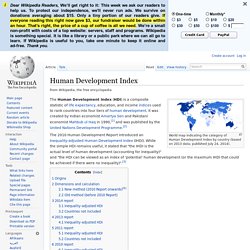
The 2010 Human Development Report introduced an Inequality-adjusted Human Development Index (IHDI). Capability approach. The capability approach (also referred to as the capabilities approach) is an economic theory conceived in the 1980s as an approach to welfare economics.[1] In this approach, Amartya Sen brings together a range of ideas that were hitherto excluded from (or inadequately formulated in) traditional approaches to the economics of welfare. The core focus of the capability approach is on what individuals are able to do (i.e., capable of). Assessing capability[edit] Initially Sen argued for five components in assessing capability: The importance of real freedoms in the assessment of a person's advantageIndividual differences in the ability to transform resources into valuable activitiesThe multi-variate nature of activities giving rise to happinessA balance of materialistic and nonmaterialistic factors in evaluating human welfareConcern for the distribution of opportunities within society Key terms[edit]
Environmental management system. Environmental management system (EMS) refers to the management of an organization's environmental programs in a comprehensive, systematic, planned and documented manner. It includes the organizational structure, planning and resources for developing, implementing and maintaining policy for environmental protection. More formally, EMS is "a system and database which integrates procedures and processes for training of personnel, monitoring, summarizing, and reporting of specialized environmental performance information to internal and external stakeholders of a firm.
Ecological footprint. (Human) ecological footprint is a measurement of anthropogenic impact on earth.
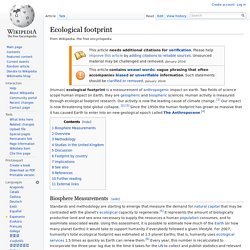
Two fields of science scope human impact on Earth; they are geospheric and biospheric sciences. Human activity is measured through ecological footprint research. Our activity is now the leading cause of climate change. [1] Our impact is now threatening total global collapse. [2] [3] Since the 1950s the human footprint has grown so massive that it has caused Earth to enter into an new geological epoch called The Anthropocene.[4] Biosphere Measurements[edit] Standards and methodology are starting to emerge that measure the demand for natural capital that may be contrasted with the planet's ecological capacity to regenerate.[5] It represents the amount of biologically productive land and sea area necessary to supply the resources a human population consumes, and to assimilate associated waste. Carrying capacity. The carrying capacity of a biological species in an environment is the maximum population size of the species that the environment can sustain indefinitely, given the food, habitat, water and other necessities available in the environment.
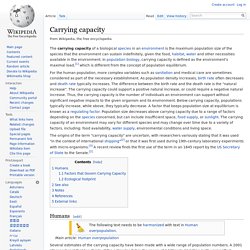
In population biology, carrying capacity is defined as the environment's maximal load,[1] which is different from the concept of population equilibrium. For the human population, more complex variables such as sanitation and medical care are sometimes considered as part of the necessary establishment. As population density increases, birth rate often decreases and death rate typically increases. Planetary boundaries. Planetary boundaries is the central concept in an Earth system framework proposed by a group of Earth system and environmental scientists led by Johan Rockström from the Stockholm Resilience Centre and Will Steffen from the Australian National University. In 2009, the group proposed a framework of “planetary boundaries” designed to define a “safe operating space for humanity” for the international community, including governments at all levels, international organizations, civil society, the scientific community and the private sector, as a precondition for sustainable development.
This framework is based on scientific research that indicates that since the Industrial Revolution, human actions have gradually become the main driver of global environmental change. Category:P2P Accounting. New metrics, evaluation and accounting methods appropriate for a collaborative, peer to peer economy. the most important ecosystem accounting system in the world: the Multi-Scale Integrated Analysis of Societal and Ecosystem Metabolism used by Senplades in Ecuador.
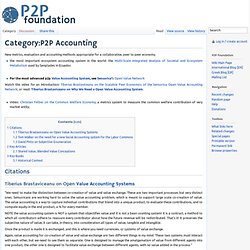
For the most advanced p2p Value Accounting System, see Sensorica's Open Value Network. Sustainability accounting. Sustainability accounting (also known as social accounting, social and environmental accounting, corporate social reporting, corporate social responsibility reporting, or non-financial reporting) was originated about 20 years ago[1] and is considered a subcategory of financial accounting that focus on the disclosure of non-financial information about a firm's performance to external parties such as capital holders, mainly to stakeholders, creditors and other authorities. These represent the activities that have a direct impact on society, environment and economic performance of an organisation. Integrated reporting. Integrated reporting <IR> can be defined as a "process that results in communication, most visibly a periodic “integrated report”, about value creation over time.
An integrated report is a concise communication about how an organization’s strategy, governance, performance and prospects lead to the creation of value over the short, medium and long term. "[1] It means the integrated representation of a company’s performance in terms of both financial and other value relevant information. Integrated Reporting provides greater context for performance data, clarifies how value relevant information fits into operations or a business, and may help embed long-termism into company decision making.
King Report on Corporate Governance[edit] Triple bottom line. Graphic describing the three types of bottom lines Triple bottom line (abbreviated as TBL or 3BL) incorporates the notion of sustainability into business decisions. The TBL is an accounting framework with three dimensions: social, environmental (or ecological) and financial. The TBL dimensions are also commonly called the three Ps: people, planet and profits and are referred to as the "three pillars of sustainability. " Interest in triple bottom line accounting has been growing in both for-profit, nonprofit and government sectors. Full cost accounting. Environmental Full cost accounting (EFCA) generally refers to the process of collecting and presenting information — about environmental, social, and economic costs and benefits/advantages (collectively known as the "triple bottom line") - for each proposed alternative when a decision is necessary.
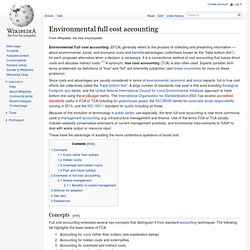
It is a conventional method of cost accounting that traces direct costs and allocates indirect costs. [1] A synonym, true cost accounting (TCA) is also often used. Experts consider both terms problematic as definitions of "true" and "full" are inherently subjective (see Green economics for more on these problems). Since costs and advantages are usually considered in terms of environmental, economic and social impacts, full or true cost efforts are collectively called the "triple bottom line".
Because of this evolution of terminology in public sector use especially, the term full-cost accounting is now more commonly used in management accounting, e.g. infrastructure management and finance. Externality. In economics, an externality is the cost or benefit that affects a party who did not choose to incur that cost or benefit.[1] Implications[edit] External costs and benefits Voluntary exchange is considered mutually beneficial to both parties involved, because buyers or sellers would not trade if either thought it detrimental to themselves.
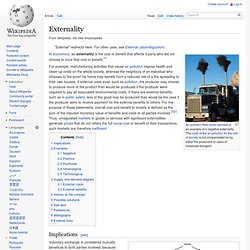
However, a transaction can cause additional effects on third parties. From the perspective of those affected, these effects may be negative (pollution from a factory), or positive (honey bees kept for honey that also pollinate neighboring crops). A voluntary exchange may reduce societal welfare if external costs exist. Total economic value. Total economic value (TEV) is a concept in cost benefit analysis that refers to the value derived by people from a natural resource, a man-made heritage resource or an infrastructure system, compared to not having it.
It appears in environmental economics as an aggregation of the (main function based) values provided by a given ecosystem. Those include use and non-use values. [citation needed] Use Value – Direct: Obtained through a removable product in nature (i.e. timber, fish, water). Non-Use Value – Indirect: Obtained through a non-removable product in nature (i.e. sunset, waterfall). Time derivative. A time derivative is a derivative of a function with respect to time, usually interpreted as the rate of change of the value of the function.[1] The variable denoting time is usually written as Notation[edit] A variety of notations are used to denote the time derivative. In addition to the normal (Leibniz's) notation, A very common short-hand notation used, especially in physics, is the 'over-dot'. I.E.